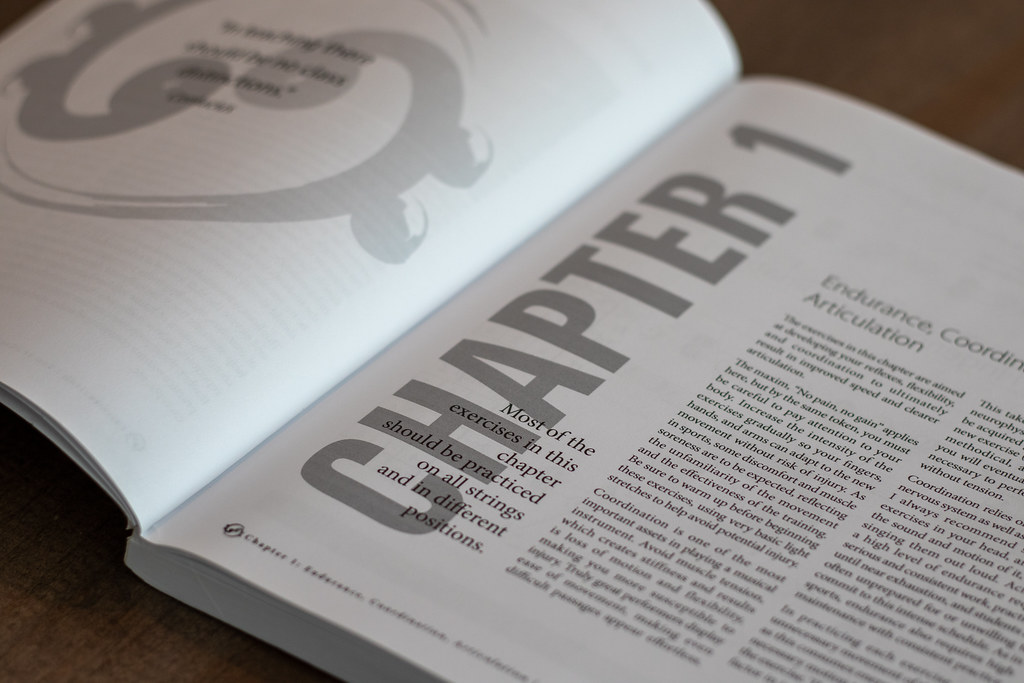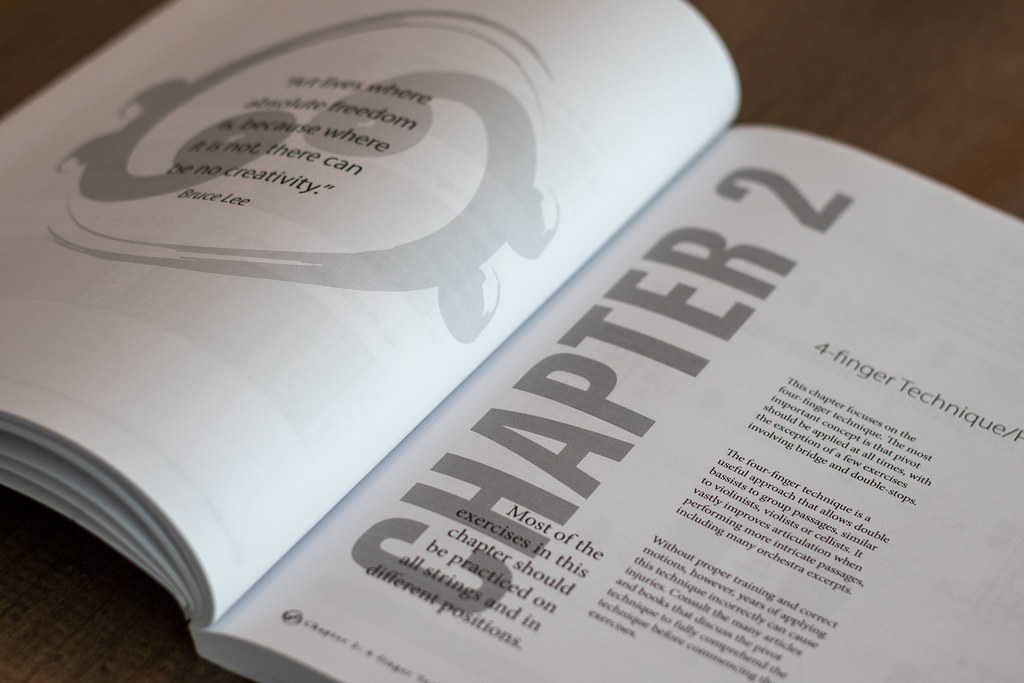I’ve been a fan of Marcos Machado’s Tao of Bass ever since it came out a few years ago. In fact, I had him on the podcast not too long after the book was published to talk about his unique way of integrating multiple technical approaches to the double bass.
At 217 pages, this book in an encyclopedia on left hand approaches that may, upon first glance, seemingly contradict each other. However, Marcos blends tradition 1-2-4 fingering, pivoting, four finger chromatic fingering, and thumb position into a stream of exercises, making me look at the bass in a different way.
Volume 1 of Tao of Bass

Also, I’d always been intrigued by the tantalizing “Volume One” on the cover, and the list of subsequent volumes that he plans on releasing:
- Volume II, Scales, Arpeggios, Chromatic Exercises
- Volume III, The Right Hand
- Volume IV, Tao of Bass Applied
I’ve spent countless hours over the years going through these exercises, adding various ones to my routine to address various issues in my technique. I’ve also learned a lot through the various lessons Marcos has put up on his Instagram and YouTube Channel.
When I heard from my good friend Geoff Chalmers of Discover Double Bass that Marcos would be heading to England to film a course, I decided to work methodically through Tao of Bass, going through the various exercises and taking notes on my progress. I thought that it would be interesting to do this work on my own and then see how my perspective would change hearing directly from Marcos through this course.
Called Integral Technique, Marcos’ course with Discover Double Bass is truly an epic look at the double bass and various fingering options in both the lower and upper positions.
It totally rocks. In fact, I wrote a review of it this past fall detailing everything that was inside.
I recently caught up with Marcos to talk about the upcoming release of volume two of the series. In addition to digging into that book (which I can’t wait to check out), we dug into his whole approach to bass technique and how Tao of Bass weaves together so many systems and approaches.
A Look Inside Volume One of Tao of Bass
As I was chatting with Marcos recently, I realized that I’d never actually done a formal review of this remarkable book. I’m taking a stab at it here, and be sure to watch the video to see more details.
There can be no one-size-fits-all in double bass playing.
Marcos Machado
I always find it interesting to see how authors of pedagogical works for the double bass frame their project. Here’s an excerpt from Marcos’ introduction to Tao of Bass which neatly encapsulates his thoughts on schools of technique:
There are many schools of double bass (Czech, German, Italian, French, Bulgarian, Hungarian, Dutch, etc.), each with its own set of rules for fingerings, bow hold, etc. While each is important for historical value, many now rely on now obsolete concepts.
He later writes:
The Tao of Bass rejects some of the rigid rules that have been present for years in some traditional double bass schools. For example, while traditional schools favor using only three fingers in the lower positions, the Tao of Bass suggests that double bassists should use all the left hand fingers equally, independently, in all positions. This will vary according to the student’s particular strengths and weaknesses; there can be no one-size-fits-all in double bass playing. Each musician should identify his or her own fingering and bowing solutions.
It has been fascinating over my life to watch attitudes in fingering change. Like many (or perhaps most) of you, I was raised on the 1-2-4 left hand approach outlined in the Simandl Method. I remember looking at the black and white photos in this book of my hero Gary Karr, trying to emulate his hand position.
It was fascinating to learn in a recent interview with Gary Karr that, in fact, he didn’t care for the Simandl Method at all.
Integrating multiple approaches with Tao of Bass
Marcos has a “yes, and…” approach to bass fingerings which I find quite refreshing. In Tao of Bass, he organizes a multitude of exercises into three basic categories.
Chapter 1: Endurance, Coordination, Articulation

Chapter 2: Four Finger Technique/Pivot

Chapter 3: Thumb Position

Within each one of these sections, he has a brief overview of the chapter in general, along with great visual layouts of how to conceive of these exercises.
For each of these chapters, he groups the fingerings according to the starting finger. This is easier to demonstrate than describe, but here’s how it works:
Chapter 1 (1-2-4)
- Group 0: starts on open string
- Group 1: starts on first finger
- Group 2: starts on second finger
- Group 4: starts on fourth finger
Chapter 2 (1-2-3-4)
- Group 1: starts on first finger
- Group 2: starts on second finger
- Group 3: starts on thirds finger
- Group 4: starts on fourth finger
Chapter 3 (T-1-2-3)
- Group +: starts on thumb
- Group 1: starts on first finger
- Group 2: starts on second finger
- Group 3: starts on thirds finger
He then goes through a series of exercises all over the corresponding region of the bass, again with helpful visuals for conceiving of where the notes are mapped out on the strings.
Marcos then takes it a step further with permutations of the groups, combining the chapter’s four finger groupings together in various ways. Here’s Marcos’ description of why he finds this beneficial:
Human beings are designed to respond to changing stimuli, and the finger permutations will thuds help stimulate and motivate students. Some of these exercises are difficult and will demand the student’s full attention. Be creative, practicing these permutations in different positions, and modulating diatonically or chromatically. Remember that shorter, more frequent practice sessions are the most effective.
In many ways, Marcos’ approach reminds me of Nicholas Slonimsky’s epic work Thesaurus of Scales and Modes, which so many musicians, including John Coltrane, used to fuel their creative approaches to technical mastery.
How I use Tao of Bass
Everyone’s going to find their own way of approaching this book. Marcos didn’t envision it at a book that you go through sequentially from page one to the end. That’s also not how I approach it, though I think you’d get a lot of benefit if you did just that.
What I do is page through one of the chapters until I find something that catches my eye. I work on that exercise very slowly, increasing the tempo gradually. I may stick with that exercise for a week, or I might add in another one as well. Each day, I look to add a slightly new challenge.
I think of it like learning a new word in a foreign language. I want to use it in different ways and find new permutations for it.
I have an item in my practice app Modacity that simply says “Tao of Bass.” That means that I’ll practice something from it every day. That might be shifting. Perhaps it’s more of an endurance exercise, or something a bit convoluted that I want to master.
Regardless of what I’m doing, I’m using it as an opportunity to push myself a bit further, to expand my tool kit for the bass, and to give me new ways of looking at passages in my solo and ensemble repertoire.
More Resources
I love the Tao of Bass and use it every day.
Of course, there are an abundance of resources out there for bassists of any level. Here’s a list of some of the things that I use and recommend all the time. If you’ve got more suggestions, feel free to leave them in the comments and we’ll keep building this list!
- If you’re just starting out, I have a list of my favorite step-by-step resources here
- Simplified Higher Technique by Franco Petracchi
- love it or not, a lot of folks find value in New Method by Franz Simandl
- Francois Rabbath’s Nouvelle Technique series continues to revolutionize double bass technique
- Hal Robinson’s Strokin’ and Boardwalkin’ have on my regular practice rotation for decades, and I recommend them to all of my intermediate and advanced students
Bass News Right To Your Inbox!
Subscribe to get our weekly newsletter covering the double bass world.


Would like to order the Tao of Bass but cannot seem to find it listed. Will admit I have not tried Amazon as I want my local bookstore to benefit. Can you give me a link to the publisher? Thanks..great work with the podcast
Thanks, James! You can order it directly from Marcos’ website at https://www.taoofbass.com/